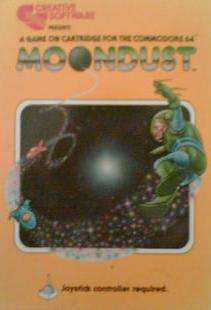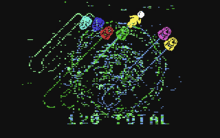Moondust (video game)
| Moondust | |
|---|---|
 Box art | |
| Publisher(s) | Creative Software |
| Designer(s) | Jaron Lanier |
| Platform(s) | Commodore 64 |
| Release date(s) | 1983 |
| Genre(s) | Music game, art game |
| Mode(s) | Single player |
Moondust is a 1983 generative music video game created for the Commodore 64 by virtual reality pioneer, Jaron Lanier. Moondust was programmed in 6502 assembly[1] in 1982,[2] and is considered the first art video game.[3][4][5] Moondust has frequently been used as an art installation piece in museum exhibitions[6] from Corcoran Gallery of Art's 1983 "ARTcade"[7] to the Smithsonian's 2012 "The Art of Video Games".[8][9] It has also been used by Lanier and others in papers and lectures as an example to demonstrate the unexpected ephemerality of digital data.[10][11][12][13]
Moondust is also considered to be the first interactive music publication,[14][15] and it sold quite successfully.[16] With the profits from Moondust[17] and additional funding from Marvin Minsky,[18] Lanier formed VPL which would later go on to create the DataGlove and the DataSuit[19] and to become one of the primary innovators of virtual-reality research and development throughout the 1980s.
Gameplay

Moondust's gameplay is characterized by graphical complexity,[20] and the game features an abstract ambient score.[21] The goal of the game is to cover the bullseye at the center of the screen with "moonjuice." To do this, the player controls spaceman Jose Scriabin (named in honor of synaesthetic composer Alexander Scriabin)[22] as he drops a seed square and then moves around the screen in arcing paths to run over the seed, smearing it to cover the bullseye. As Jose travels, flight patterns of he and the bullet-shaped spaceships he must avoid are created and as they pass through the trails that are created, and as the moonjuice spreads and smears, the musical score is modified according to a generative algorithm.[23] In-game scoring system assigns point-values according to an algorithm when the level is completed. Players start with three seeds but may acquire more if they have scored highly enough.[22] The game has been compared to the works of Jeff Minter.[24]
The game features 4 modes: Beginner, Evasive, Freestyle, and Spinsanity. In Beginner mode, the seeds that Jose must smear remain in one position wherever they had been dropped. In Evasive mode, however, the seeds seek to evade Jose by rushing to the edge of the screen. Freestyle mode greatly increases the players control over Jose, removing the physical element of momentum to connect Jose's motions directly to the joystick controller's. In Spinsanity mode, the spaceships travel in a spiral pattern making smearing of the seed more difficult for the player.[22]
Reception
Ahoy!'s review began "And now for something completely different. You have never seen anything like Moondust ... No mazes, no nuke the alien aggressors, no 'find ring, sit on ring'". The magazine, which gave the game a grade of B for graphics and A for gameplay, stated that it was "not for everybody", warning that "the instructions are confusing. Even the people at Creative Software didn't know what Lanier was up to". The review nonetheless concluded "Players shopping for a non-violent game that incorporates graphics and music will want to consider Moondust ... I recommend it".[25]
References
- ↑ "Brief Biography of Jaron Lanier". Homepage of Jaron Lanier. Retrieved 2008-09-11.
- ↑ Manes, Stephen, Time and Technology Threaten Digital Archives . . .. New York Times - Science. 7 April 1998.
- ↑ Pease, Emma. CSLI Calendar Of Public Events. Stanford Center for the Study of Language and Information. 14 May 1997.
- ↑ Jaron Lanier. KurzweilAI.net entry. Retrieved 2 February 2013.
- ↑ Thomsen, Michael. "Super Mario Turns 25: How Nintendo redefined everything before and after." IGN. 18 October 2010.
- ↑ Amirkhanian, Charles. New Music in the Bay Area. KPFA Folio KPFA FM94, Listener-Sponsored Pacifica Radio program guide. October 1983
- ↑ Blakeman, Mary Claire. "The Art Side of Video Games." Video Games. Vol.2, No.4. Pp.27-30. January 1984.
- ↑ Thomsen, Michael. "Review: The Smithsonian Celebrates Video Games - America's first art museum and The Art of Video Games." IGN. 30 March 2012.
- ↑ Thomsen, Michael. "Culture Clash: How Video Games Are Crashing the Museum Party." Gamasutra. 22 May 2012.
- ↑ Neumann, Horst. How Long Will Digitised Data Last?. The Journal of the Launceston Computer Group Inc. Volume 1, Issue 3. April 2005.
- ↑ Van der Reijden, Anna Denise. Authenticity in Internet Art. University of Utrecht masters thesis. August 2008.
- ↑ "Clockthoughts". Homepage of Jaron Lanier. Retrieved 2008-09-11.
- ↑ Manes, Stephen. "Technology - Time and Technology Threaten Digital Archives . . .." New York Times. 7 April 1998.
- ↑ Demarinis, Paul. Review of Jaron Lanier’s Moondust. Computer Music Journal Volume 08, No. 2 (Summer 1984), p. 61
- ↑ Donovan, Tristan. "Inside Music Games - Let's face the music and dance." Eurogamer. 10 August 2011.
- ↑ Chesher, Chris. Colonizing Virtual Reality - Construction of the Discourse of Virtual Reality, 1984-1992. Cultronix. Volume 1, Number 1. Fall 1994.
- ↑ Burr, Snider. Jaron. Wired. May/June 1993.
- ↑ Virtual reality: spreadsheets for industry - tutorial. RELease 1.0. 8 October 1990.
- ↑ Hamilton, Joan O'C. Going Where No Minds Have Gone Before. 5 October 1992.
- ↑ Burkeman, Oliver. The virtual visionary. The Guardian. 29 December 2001.
- ↑ Silfer, Kyle. Applied Ludology - Art games and game art. Alibi. Volume 16, Number 28. 12–18 July 2007.
- 1 2 3 Blakeman, Mary Claire. "The Art Side of Video Games - Moondust: Music Of Your Own Making." Video Games. Vol.2, No.4. Pp.27-30. January 1984.
- ↑ Brownstein, Mark. "Computer Corner - The Year in Review: Shockwaves in the Computer Industry - Moondust." Video Games. No.17 (Vol.2, Iss.5). P.65. February 1984. ISSN 0733-6780
- ↑ Moondust . MayhemUK Commodore 64 Archive review. Retrieved 9 November 2008.
- ↑ Michaels, R. J. (January 1984). "Moondust". Ahoy!. p. 52. Retrieved 27 June 2014.